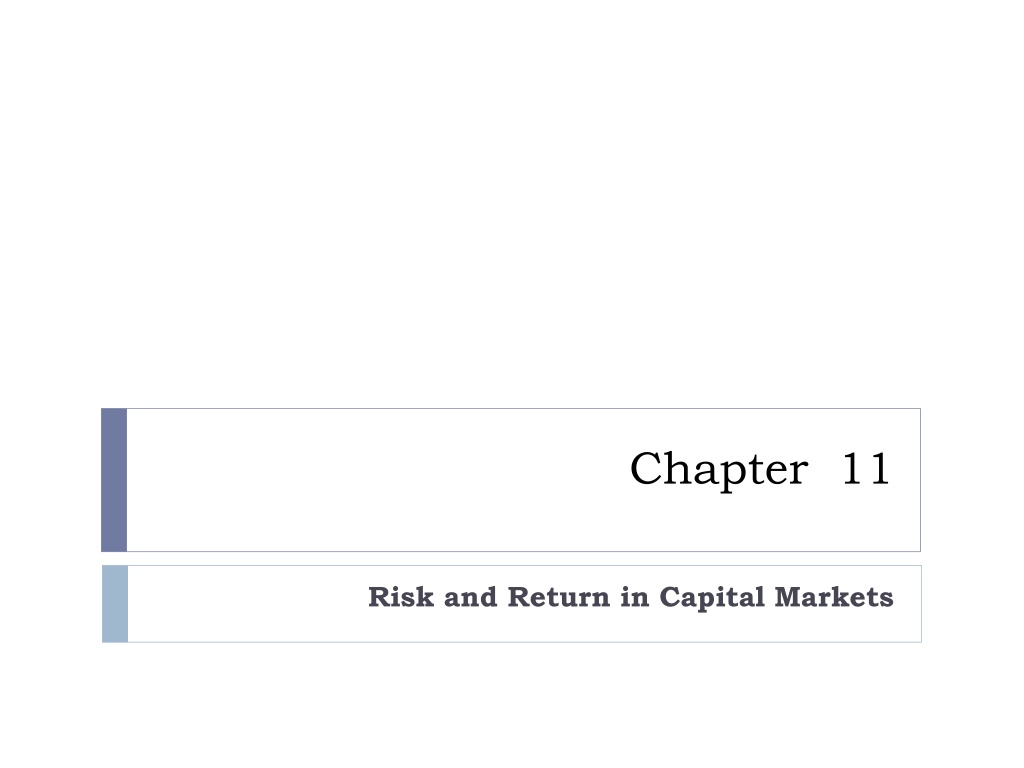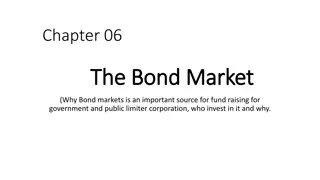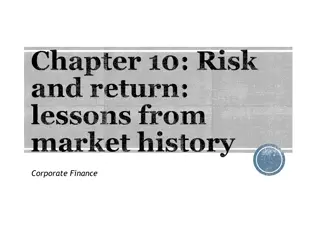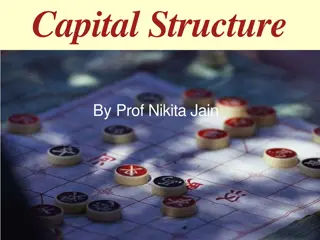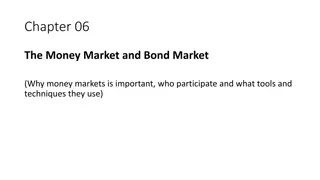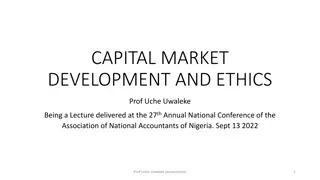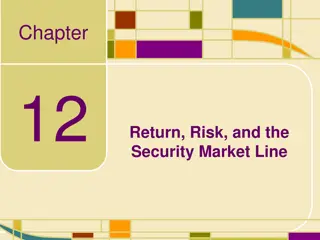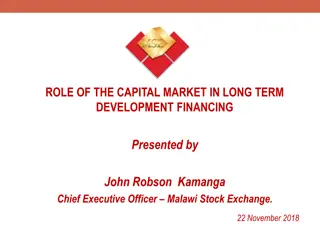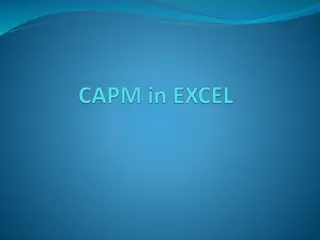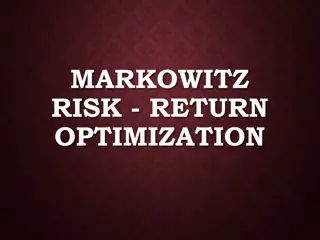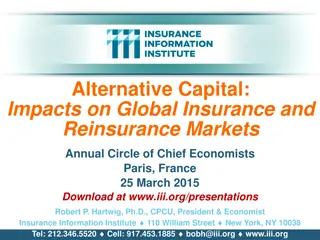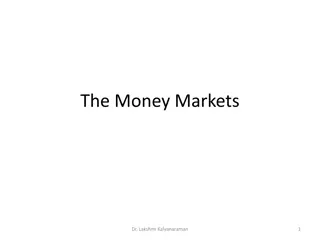Understanding Risk and Return in Capital Markets
This chapter delves into the concepts of risk and return in capital markets, exploring historical trends, tradeoffs, common versus independent risk, and the importance of diversification in stock portfolios. Readers will discover the performance of various types of securities over time and gain insights into the relationship between risk and return in investment decisions.
Download Presentation

Please find below an Image/Link to download the presentation.
The content on the website is provided AS IS for your information and personal use only. It may not be sold, licensed, or shared on other websites without obtaining consent from the author. Download presentation by click this link. If you encounter any issues during the download, it is possible that the publisher has removed the file from their server.
E N D
Presentation Transcript
Chapter 11 Risk and Return in Capital Markets
Chapter Outline 11.1 A First Look at Risk and Return 11.2 Historical Risks and Returns of Stocks 11.3 The Historical Tradeoff Between Risk and Return 11.4 Common Versus Independent Risk 11.5 Diversification in Stock Portfolios 2
Learning Objectives Identify which types of securities have historically had the highest returns and which have been the most volatile Compute the average return and volatility of returns from a set of historical asset prices Understand the tradeoff between risk and return for large portfolios versus individual stocks Describe the difference between common and independent risk Explain how diversified portfolios remove independent risk, leaving common risk as the only risk requiring a risk premium 3
11.1 A First Look at Risk and Return Consider how an investment would have grown if it were invested in each of the following from the end of 1925 until the beginning of 2010: Standard & Poor s 500 (S&P 500) Small Stocks World Portfolio Corporate Bonds Treasury Bills 4
Figure 11.1 Value of $100 Invested at the End of 1925 in U.S. Large Stocks (S&P 500), Small Stocks, World Stocks, Corporate Bonds, and Treasury Bills 5
Table 11.1 Realized Returns, in Percent (%) for Small Stocks, the S&P 500, Corporate Bonds, and Treasury Bills, Year-End 1925 1935 6
11.2 Historical Risks and Returns of Stocks Computing Historical Returns Realized Returns:the total return that occurs over a particular time period. Individual Investment Realized Returns The realized return from your investment in the stock from t to t+1 is: + Div P P Div P P (Eq. 11.1) = = + + + + + 1 1 1 1 t t t t t t R + 1 t P P Dividend Yield Capital Gain Yield + P t t t = 7
Example 11.1 Realized Return Problem: Microsoft paid a one-time special dividend of $3.08 on November 15, 2004. Suppose you bought Microsoft stock for $28.08 on November 1, 2004 and sold it immediately after the dividend was paid for $27.39. What was your realized return from holding the stock? 8
Example 11.1 Realized Return Execute: Using Eq. 11.1, the return from Nov 1, 2004 until Nov 15, 2004 is equal to + 3.08 (27.39 + Div P P 28.08) = = = + + 1 1 t t t 0.0851, or 8.51% R + 1 t 28.08 P t This 8.51% can be broken down into the dividend yield and the capital gain yield: 3.08 28.08 Div = = + 1 Dividend Yield = .1097, or 10.97% t P t ( ) 27.39 28.08 28.08 P P = 0.0246, or = + 1 Capital Gain Yield = 2.46% t t P t 9
Example 11.1a Realized Return Problem: Health Management Associates (HMA) paid a one-time special dividend of $10.00 on March 2, 2007. Suppose you bought HMA stock for $20.33 on February 15, 2007 and sold it immediately after the dividend was paid for $10.29. What was your realized return from holding the stock? 10
Example 11.1a Realized Return Execute: Using Eq. 11.1, the return from February 15, 2007 until March 2, 2007 is equal to + + Div P P 10 00 . 10 29 . 20 33 . = = = . 0 2 . 0 R 002 , or % + + t 1 t 1 t + t 1 P 20 33 . t This -0.2% can be broken down into the dividend yield and the capital gain yield: 10.00 20.33 P Div = = = + 0.4919, 49.19% 1 t DividendYield or P t 10.29 20.33 20.33 P = = = + 0.4939, 49.39% 1 t t CapitalGainYield or P t 11
Example 11.1b Realized Return Problem: Limited Brands paid a one-time special dividend of $3.00 on December 21, 2010. Suppose you bought LTD stock for $29.35 on October 18, 2010 and sold it immediately after the dividend was paid for $30.16. What was your realized return from holding the stock? 12
Example 11.1b Realized Return Execute: Using Eq. 11.1, the return from October 18, 2010 until December 21, 2010 is equal to + + 3.00 30.16 29.35 29.35 Div P P = = = + + 0.1298,or0.12.98% 1 1 t t t R + 1 t P t This 12.98% can be broken down into the dividend yield and the capital gain yield: 3.00 29.35 P Div = = = + 0.1022,or10.22% 1 t DividendYield P t 30.16 29.35 29.35 P = = = + 0.0276,or2.76% 1 t t CapitalGainYield P t 13
11.2 Historical Risks and Returns of Stocks Computing Historical Returns Individual Investment Realized Returns For quarterly returns (or any four compounding periods that make up an entire year) the annual realized return, Rannual, is found by compounding: + = + + + + 1 (1 )(1 )(1 )(1 ) annual R R R R R (Eq. 11.2) 1 2 3 4 14
Example 11.2 Compounding Realized Returns Problem: Suppose you purchased Microsoft stock (MSFT) on Nov 1, 2004 and held it for one year, selling on Oct 31, 2005. What was your annual realized return? 15
Example 11.2 Compounding Realized Returns Plan (cont d): Next, compute the realized return between each set of dates using Eq. 11.1. Then determine the annual realized return similarly to Eq. 11.2 by compounding the returns for all of the periods in the year. 16
Example 11.2 Compounding Realized Returns Execute: In Example 11.1, we already computed the realized return for Nov 1, 2004 to Nov 15, 2004 as 8.51%. We continue as in that example, using Eq. 11.1 for each period until we have a series of realized returns. For example, from Nov 15, 2004 to Feb 15, 2005, the realized return is + + Div P P 0.08 (25.93 27.39) 27.39 = = 0.0504, or 5.04% = + + 1 1 t t t R + 1 t P t 17
Example 11.2 Compounding Realized Returns Execute (cont d): The table below includes the realized return at each period. 18
Example 11.2 Compounding Realized Returns Execute (cont d): We then determine the one-year return by compounding. ( ) + + = = + + + + + 1 1 R (1 (1.0851)(0.9496)(0.9861)(1.0675)(0.9473) 1.0275 1 .0275 or 2.75% = )(1 )(1 )(1 ) 1 annual R R R R R R R 1 2 3 4 5 = 1.0275 annual = annual 19
Example 11.2 Compounding Realized Returns Evaluate: By repeating these steps, we have successfully computed the realized annual returns for an investor holding MSFT stock over this one-year period. From this exercise we can see that returns are risky. MSFT fluctuated up and down over the year and ended-up only slightly (2.75%) at the end. 20
Example 11.2a Compounding Realized Returns Problem: Suppose you purchased Health Management Associate s stock (HMA) on March 16, 2006 and held it for one year, selling on March 15, 2007. What was your realized return? 21
Example 11.2a Compounding Realized Returns Plan (cont d): Date Price Dividend 16-Mar-06 10-May-06 9-Aug-06 8-Nov-06 15-Feb-07 2-Mar-07 15-Mar-07 21.15 20.70 20.62 19.39 20.33 10.29 11.07 0.06 0.06 0.06 10.00 Next, compute the realized return between each set of dates using Eq. 11.1. Then determine the annual realized return similarly to Eq. 11.2 by compounding the returns for all of the periods in the year. 22
Example 11.2a Compounding Realized Returns Execute: In Example 11.1a, we already computed the realized return for February 15, 2007 to March 2, 2007 as -.2%. We continue as in that example, using Eq. 11.1 for each period until we have a series of realized returns. For example, from August 9, 2006 to November 8, 2006, the realized return is + + Div P P . 0 06 19 39 . 20 62 . = = = 0567 . 0 R , or . 5 67 % + + t 1 t 1 t + t 1 P 20 62 . t 23
Example 11.2a Compounding Realized Returns Execute (cont d): The table below includes the realized return at each period. Date 16-Mar-06 10-May-06 9-Aug-06 8-Nov-06 15-Feb-07 2-Mar-07 15-Mar-07 Price Dividend Return 21.15 20.70 20.62 19.39 20.33 10.29 11.07 0.06 0.06 0.06 -1.84% -0.10% -5.67% 4.85% -0.20% 7.58% 10.00 24
Example 11.2a Compounding Realized Returns Execute (cont d): We then determine the one-year return by compounding. ( ( or ) ) % + = + + + + + + 1 1 ( )( 1 ) 1 1 ( )( 1 )( 1 ) annual R R R R R R R 1 2 3 4 5 6 + = 1 R . 0 ( 982 . 0 )( = 999 ) . 0 943 . 1 ( 048 . 0 )( 998 . 1 )( 076 ) annual R 0411 . 1 = 1 0411 . . 4 11 annual 25
11.2 Historical Risks and Returns of Stocks Average Annual Returns Average Annual Return of a Security 1( T = + + + ... ) R R R R (Eq. 11.3) 1 2 T 26
Figure 11.2 The Distribution of Annual Returns for U.S. Large Company Stocks (S&P 500), Small Stocks, Corporate Bonds, and Treasury Bills, 1926 2009 27
Figure 11.3 Average Annual Returns in the U.S. for Small Stocks, Large Stocks (S&P 500), Corporate Bonds, and Treasury Bills, 1926 2009 28
11.2 Historical Risks and Returns of Stocks The Variance and Volatility of Returns: Variance 1 ( ) ( ) = + + ... ( + 2 2 2 (Eq. 11.4) ( ) ( ) ) Var R R R R R R R 1 2 T 1 T Standard Deviation ( ) = ( ) SD R Var R (Eq. 11.5) 29
Example 11.3 Computing Historical Volatility Problem: Using the data from Table 11.1, what is the standard deviation of the S&P 500 s returns for the years 2005-2009? 30
Example 11.3 Computing Historical Volatility Execute: In the previous section we already computed the average annual return of the S&P 500 during this period as 3.1%, so we have all of the necessary inputs for the variance calculation: Applying Eq. 11.4, we have: 1 = + + ... ( + 2 2 2 ( ) ( ) ( ) ) Var R R R R R R R 1 2 T 1 T 1 ( ) ( ) 2 2 = (.049 .031) + (.158 .031) + (.055 .031) 0.370 .031 + + .265 .031 2 2 2 5 1 .058 = 31
Example 11.3 Computing Historical Volatility Execute (cont'd): Alternatively, we can break the calculation of this equation out as follows: Summing the squared differences in the last row, we get 0.233. Finally, dividing by (5-1=4) gives us 0.233/4 =0.058 The standard deviation is therefore: = = = ( ) ( ) .058 0.241,or 24.1% SD R Var R 32
Example 11.3a Computing Historical Volatility Problem: Using the data from Table 11.1, what is the standard deviation of small stocks returns for the years 2005-2009? 33
Example 11.3a Computing Historical Volatility Solution: Plan: Year Small Stocks Return 5.69% 2005 2006 16.17% 2007 -5.22% 2008 -36.72% 2009 28.09% First, compute the average return using Eq. 11.3 because it is an input to the variance equation. Next, compute the variance using Eq. 11.4 and then take its square root to determine the standard deviation as shown in Eq. 11.5. 34
Example 11.3a Computing Historical Volatility Execute: Using Eq. 11.3, the average annual return for small stocks during this period is: 1 5 R = (.0569 .1671 .0522 .3672+.2809) + = .0171 We now have all of the necessary inputs for the variance calculation: Applying Eq. 11.4, we have: 1 = + + ... ( + 2 2 2 ( ) ( ) ( ) ) Var R R R R R R R 1 2 T 1 T 1 ( ) ( ) 2 2 = (.0569 .0171) + (.1671 .0171) ( .0522 0171) + .3672 .0171 + + .2809 .0171 2 2 2 5 1 .0615 = 35
Example 11.3a Computing Historical Volatility Execute (cont'd): Alternatively, we can break the calculation of this equation out as follows: 2005 0.0569 0.0171 0.0398 0.0016 2006 0.1671 0.0171 0.15 0.0225 2007 -0.0522 0.0171 -0.0693 0.0048 2008 -0.3672 0.0171 -0.3843 0.1477 2009 0.2809 0.0171 0.2638 0.0696 Return Average Difference Squared Summing the squared differences in the last row, we get 0.2462. Finally, dividing by (5-1=4) gives us 0.2462/4 =0.0615 The standard deviation is therefore: = = = ( ) ( ) 0.0615 0.2480, 24.80% SD R Var R or 36
Figure 11.4 Volatility (Standard Deviation) of U.S. Small Stocks, Large Stocks (S&P 500), Corporate Bonds, and Treasury Bills, 1926 2009 37
11.2 Historical Risks and Returns of Stocks The Normal Distribution 95% Prediction Interval Average R (2 x SD R ) (2 x standard deviation) ( ) (Eq. 11.6) About two-thirds of all possible outcomes fall within one standard deviation above or below the average 38
Example 11.4 Confidence Intervals Problem: In Example 11.3 we found the average return for the S&P 500 from 2005- 2009 to be 3.1% with a standard deviation of 24.1%. What is a 95% confidence interval for 2010 s return? 40
Example 11.4 Confidence Intervals Solution: Plan: We can use Eq. 11.6 to compute the confidence interval. 41
Example 11.4 Confidence Intervals Execute: Using Eq. 11.6, we have: Average (2 standard deviation) = 3.1% (2 24.1%) to 3.1% + (2 24.1% ) = 45.1% to 51.3%. 42
Example 11.4 Confidence Intervals Evaluate: Even though the average return from 2005 to 2009 was 3.1%, the S&P 500 was volatile, so if we want to be 95% confident of 2010 s return, the best we can say is that it will lie between 45.1% and +51.3%. 43
Example 11.4a Confidence Intervals Problem: The average return for small stocks from 2005-2009 was 1.71% with a standard deviation of 24.8%. What is a 95% confidence interval for 2010 s return? 44
Example 11.4a Confidence Intervals Solution: Plan: We can use Eq. 11.6 to calculate the confidence interval. 45
Example 11.4a Confidence Intervals Execute: Using Eq. 11.6, we have: Average 2 standarddeviation = + 1.71% (2 24.8%)to1.71% (2 24.8%) 47.89%to50.77% = 46
Example 11.4a Confidence Intervals Evaluate: Even though the average return from 2005-2009 was 1.71%, small stocks were volatile, so if we want to be 95% confident of 2010 s return, the best we can say is that it will lie between -47.89% and +50.77%. 47
Example 11.4b Confidence Intervals Problem: The average return for corporate bonds from 2005-2009 was 6.49% with a standard deviation of 7.04%. What is a 95% confidence interval for 2010 s return? 48
Example 11.4b Confidence Intervals Solution: Plan: We can use Eq. 11.6 to calculate the confidence interval. 49
Example 11.4b Confidence Intervals Execute: Using Eq. 11.6, we have: Average 2 standarddeviation = + 6.49% (2 7.04%)to6.49% (2 7.04%) 7.59%to20.57% = 50
